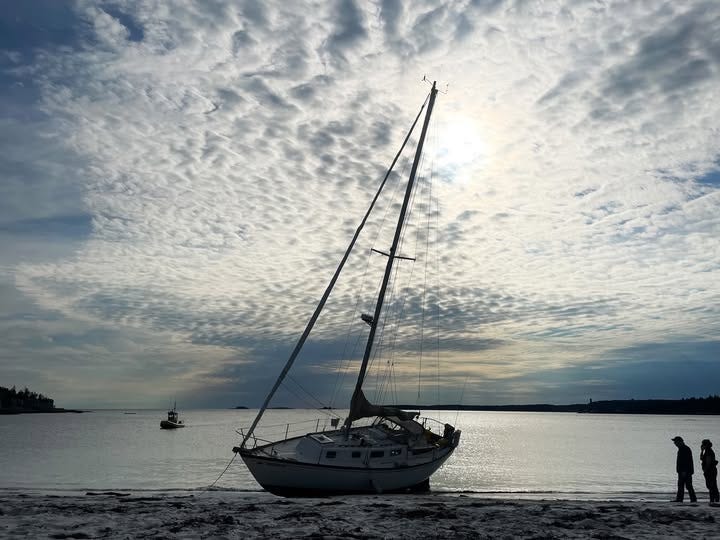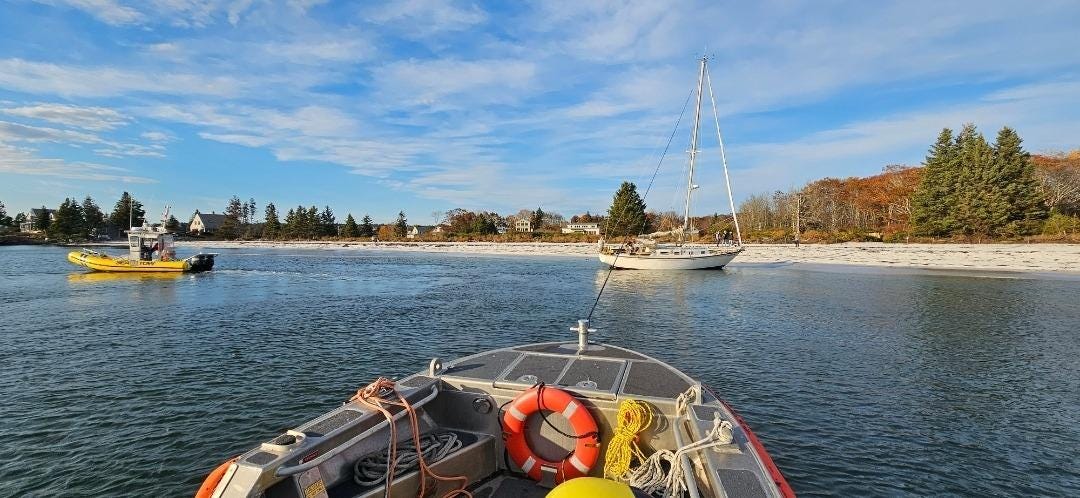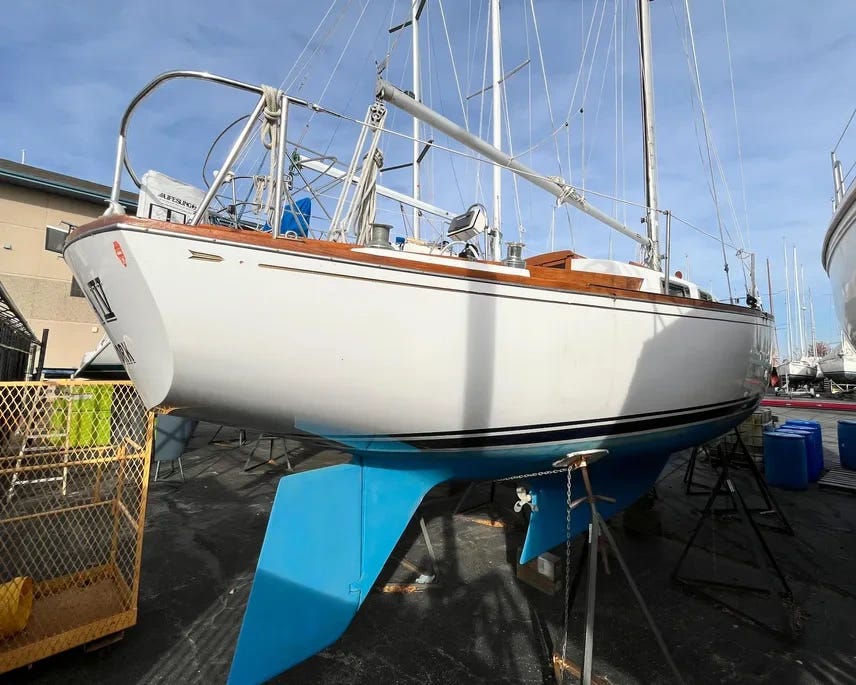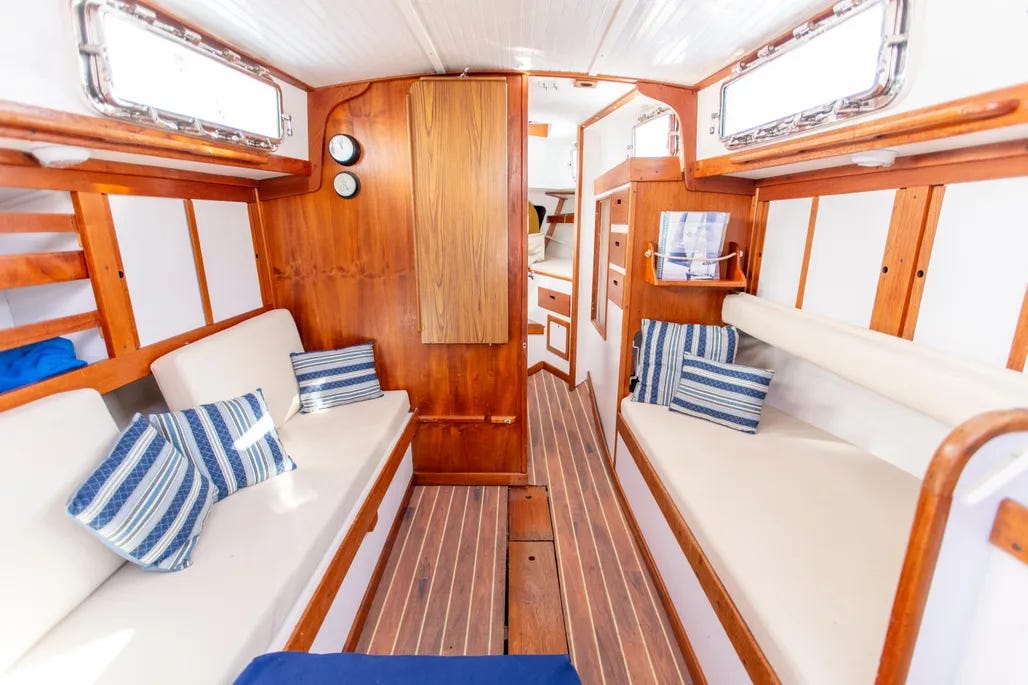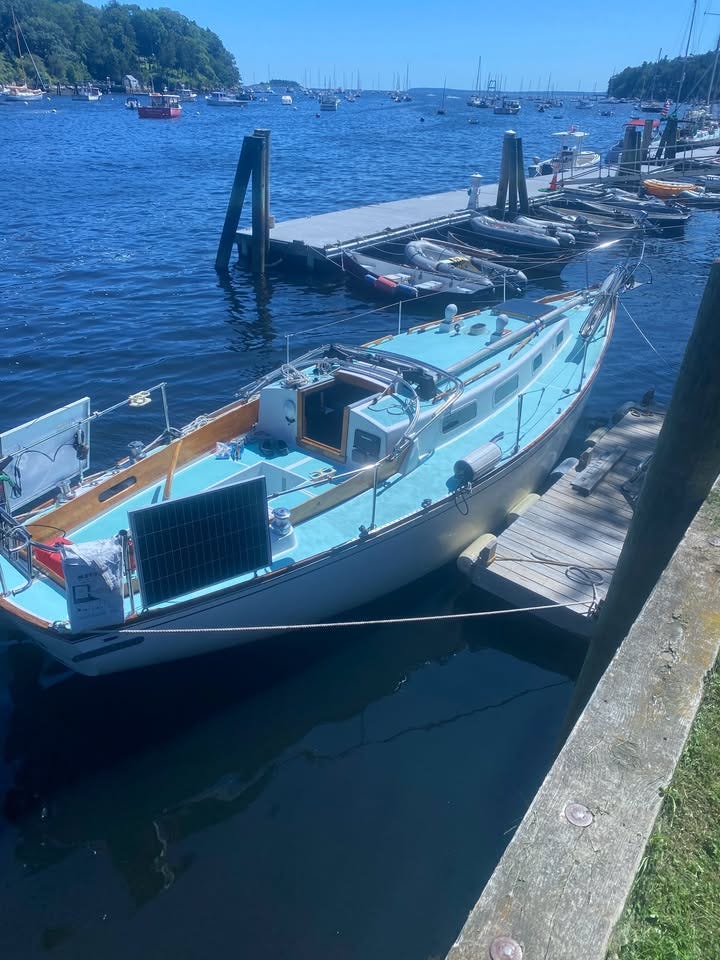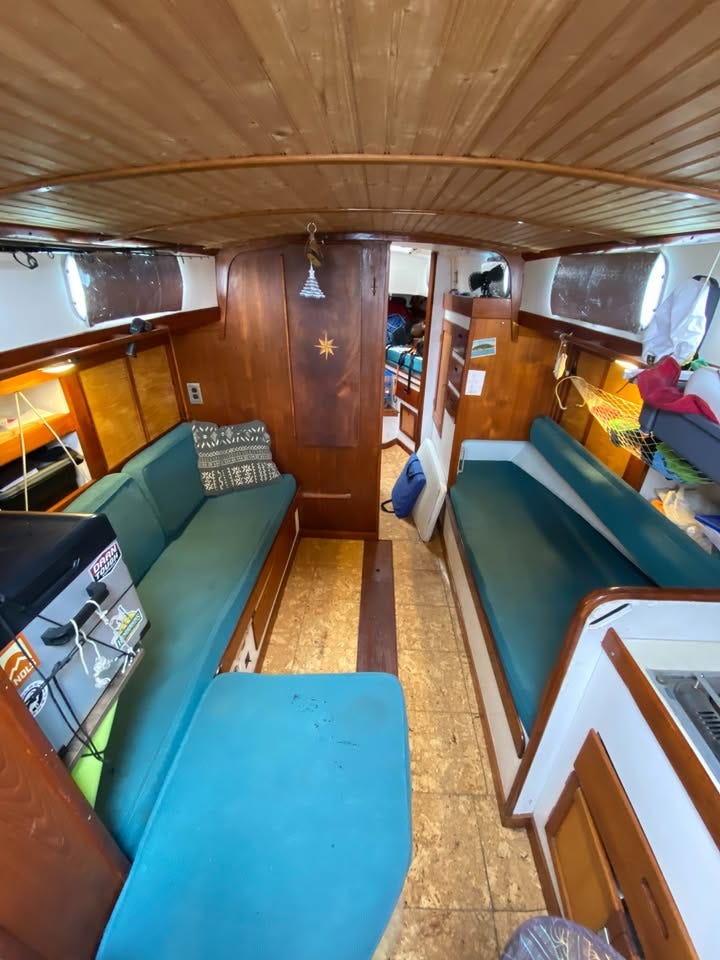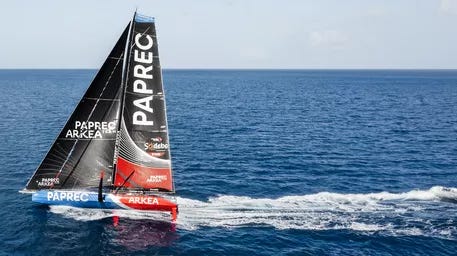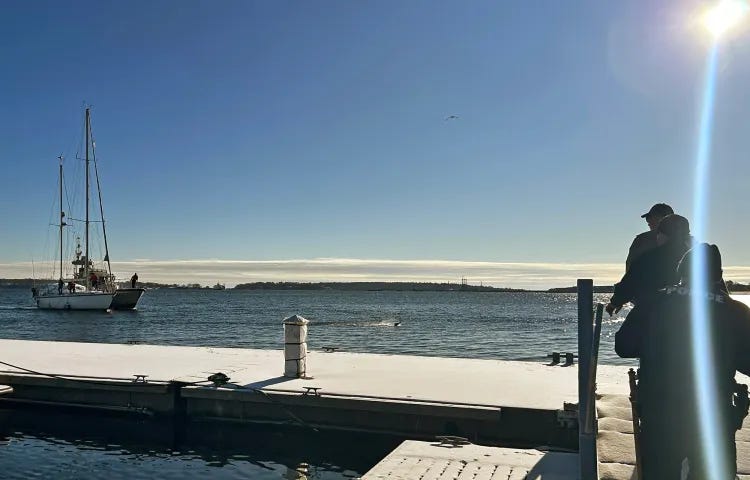The First Tack: Your Insider’s Guide to the Tartan 34C! ⛵📈
This classic does a lot of things right!
In this issue we’re going to take an in-depth look at the venerable Tartan 34C. We profiled one of these back on September 28 and the response was very robust - not only on account of its rock bottom price of $5,000 but also due to its condition (which wasn’t great - more on this later). So, we thought we’d explore the market and see what’s what for these classics.
The first Tartan 34C rolled off the production line in 1968 with the last of the 525 produced in 1978. This was a very successful sailboat for Tartan mostly due to its decent turn of speed, ease of use, and seaworthiness. She is a solid handling boat all the way around. The Tartan 34C we profiled was certainly not the best example of one of these boats, but she was loaded with potential and we deemed her to be worthy of someone’s time and effort. The old DIY special. For $5,000, what could possibly go wrong? Sure enough, she sold in short order and was sailed away - because despite the work that needed to be done, she was in sail away condition. Unfortunately, the new owner ran into trouble - literally running aground off Pemaquid, ME, on his journey south from Bar Harbor.
Luckily, no one was hurt and the boat was successfully hauled off the beach with reported damages amounting to a bent rudder post and a bruised ego. Fair enough. We all know the saying about running aground… When you look at the The BoatFools Market Report (this is all of the data we’ve collected on the sailboats we have profiled - check it out! It’s a live document and it will update as necessary. It is best viewed horizontally on your phone.), you’ll note we gave her a condition rating of C5. In short, she was seaworthy but in need of some some work. And, to be clear, her condition had nothing to do with the grounding!
So, what is the market value range for these versatile Tartans? Well, as of the writing of this newsletter, there are currently 5 on the market listed by brokers and several others listed by owners (or as we say: FSBO - For Sale By Owner). The listing price range is $15,000 - $38,500. So, whoever snatched this one for $5,000 had some room to make improvements and be comfortably within the active market range. According to JD Power, the average sale price for the Tartan 34C is $17,400.
There is an active online community for the Tartan 34 C (the C stands for Classic) and they even have their own community marketplace which you can access here. It’s hard to tell what has sold and what hasn’t so that data is not included this market overview. But one can easily see that there’s a robust and active community (nearly 1,000 members on Facebook alone!) for these lovely boats.
If you’re looking for more of a turn-key version of this classic, we’d recommend looking at this one which is at the top of the range and $38,500. She’s located in Kenosha, WI, so if you’re not near there, the distance could be a deal breaker.
Many of these originally came with the Atomic 4 - a loved AND hated engine. If you’re a diesel person, this WI one has a Westerbeke that was installed in 2014. If you’re in the Atomic 4 camp and like to work on gasoline engines, and would prefer a tiller, this Tartan 34C seems pretty darn nice. I have seen her from the outside in a local boatyard and she looks ready to go - at $24,000 (though I’ve also seen her listed at $22k). She has the original (or updated) cork sole which looks to be in pretty decent shape!
So, what do we make of these Tartan 34Cs? Having been on one, I can say that they would be ideal for a solo sailor, a couple, or even a small family. They would make ideal daysailers, weekenders, or coastal cruisers (and beyond!) - and would be great for getting into some shallower anchorages on account of their centerboard configuration, drawing just shy of 4 feet with the board up, and nearly 8.5 feet with it down.
These boats have pretty lines with a nice sheer - a look that never grows old, in our opinion. Her rudder is protected by a skeg but the one flaw that jumps out at me, on account of sailing in Maine, is the prop which is not in an aperture but protruding from the aft end of the long shoal keel. It’s mildly protected here and likely fine in most sailing waters that aren’t littered with lobster buoys. On the other hand, the ADVANTAGE of this is that it necessitates the engine location to be in the main salon, under a settee, thus making engine access superb.
The Tartan 34C will generally have good sailing characteristics - stable, comfortable, and with a cockpit ready for entertaining or relaxing.

Here are some pros and cons for the Tartan 34C. These are not our words but compiled from various sources, including owner’s forums:
“The Tartan 34C is capable of crossing oceans if you are up to it and your boat is prepared. Cruising the upper Chessy in a T34C should be a blast. The center board will allow you get into many shallow anchorages that deeper keels will not permit.
Potential issues with this boat:
- chain plates; these can go bad and need to be re-done
- center board pennant; this is important, especially on the shallow Chessy. If the lowering/raising mechanism fails you may not be able to get back to your home port.”
“Only real areas of concern would be to check the foredeck for any gel coat cracks and/or delamination issues, particularly around the the forward edge of the coach roof and around the pulpit. The CB pivot pin can be an issue, but many - most of these boats have likely had it replaced already. Check to see if it has been done. If not it will likely need it in the not too distant future. Not a huge job, but a bit of a pain in the back side. Inside CB controls are easy to fix if there are any issues. CB drooping below the trunk is a very common problem, but I have found it is easy to fix with some minor adjustments on the cable/winch. Lower rudder bearing is reported by some owners to need replacing, but I haven't had any issues with it. Check the rubber exhaust muffler that is located under the chart table. They are getting old and can fail allowing exhaust and cooling water to dump into the boat. Replacement mufflers are no longer available, but there are ways around it.”
“Note that the centerboard is held in both directions by the cable which means you will snap the cable if you bump. It sails fine with it up except on a beat and I suspect you will keep it raised much of the time where you are. T34C owners baby their engines because it's so easy. You will love the access and the heat is not terrible, but you will feel it after extended motoring. Use the exhaust blower. Or just sail. The chainplates of the T34C (at least late models) are very simple compared to later model Tartans and should not be an issue. But these boats are old and many have lived 35+ years in salt. As with any fitting, if you can spot rust, pull it and check. Buy it and have a ball.”
"They are a very easy handling boat which handles much worse conditions than we do. They are easy boats to single or double hand. A larger crew gets in the way in the narrow cockpit unless they are well trained. It will get to 6 knots in any wind over 10 knots on all points of sail except downwind where it wallows. Common issues:
Centerboard -- The original design was poor. The board pivots on a square pin which tends to round out the point of attachment resulting in a drooping board. The fix isn't terribly difficult and is laid out on the Tartan 34c website.
Deck -- Most of these boats either have moisture in the balsa core or have had it repaired. Mostly it seems to get in at the chainplates though sometimes at the hull-deck joint. Very fixable, but not inexpensive unless you can do it yourself.
Engine -- Many came with Universal A4's. Many now have diesels. There are religious arguments about which is to be preferred. I like diesel. Engine access is better than any other boat I have ever been on.
Wheel or tiller -- I have a wheel. The wheel is forward in the cockpit and a major reason why it is hard for more than two people to be moving around working the boat.”
“This boat very quickly goes to looking like hell, if money and attention are not lavished on her. Kept painted and varnished, this boat easily rivals a Hinckley in beauty, but it's generally not a rich-mans boat, and they get to looking tired fast.
Other complaints are some of the frankly cheap detailing you'll find on still original models. The original salon table is a cheap-looking formica (especially surrounded by all the teak in the rest of the cabin), and the cabinets and overhead are originally made of a type of cardboard. This is all easily replaced, of course.
Finally, resale value is low, no matter what you do to her. It's a classic, but not a "romantic" in the sense of a Pilot 35. I've seen ones that have completely gone to hell that sell for under $15K, and absolute gems that are in better than new condition with shiny bronze fittings and ports, new awlgrip and the like, that only fetch $25-30K. It's a boat for enthusiasts.
I'm highlighting the critical, only because it's easy to find praise for this model. It's a great boat with a solid pedigree. If I lost mine to a hurricane or something, I'd go hunt down another.”
FINAL THOUGHTS:
This is a Sparkman & Stephens design - so there’s that. We are huge fans of their designs and they have stood the test of time, no doubt about it. Additionally, Tartan is still in business. That is not something to scoff at. These boats are an ideal size, and while they may not have the volume of a modern 34-footer, one will certainly not cost you as much…
WHAT DO YOU LIKE/DISLIKE ABOUT THE TARTAN 34C?
NAVIGATING SAILBOAT OWNERSHIP
The yearly maintenance costs for a Tartan 34C sailboat (or similarly sized sailboats) vary based on factors like location, usage, and condition. Here’s a breakdown of common expenses:
1. Storage Costs
Winter Storage: $500–$2,000 (depending on the region and type of storage, such as indoor heated vs. outdoor covered). If you can store it at your house, that is ideal (though your spouse may ask for a divorce)
Mooring or Marina Fees: $500–$6,000 annually (varies significantly by location). In mid coast Maine, our mooring costs us about $450/year.
2. Insurance
Typical cost: $500–$1,100 per year
Influenced by the boat’s value, location, and level of coverage.
3. Regular Maintenance
Hull Cleaning and Polishing: $200–$500 (unless you DIY - then it’s just the cost of the wax, etc)
Bottom Paint: $300–$1,200 (yearly or bi-yearly, depending on usage). Again, less if you DIY. A boat this size will require less than 1 gallon of bottom paint.
Deck Maintenance: $100–$400 (cleaning, teak care, etc.)
Engine Servicing: $150–$500 (oil changes, fuel filters, etc.). Learn to do this yourself. It is easy to do and you should learn how.
Sails and Rigging: $200–$1,000 (inspection, cleaning, minor repairs). Cleaning your sails is key. Find a local sail loft for best results. There is an art to it.
4. Equipment Replacement and Upgrades (rarely will these be annual costs!)
Safety Gear: $100–$500 (life jackets, flares, fire extinguishers, etc.)
Electronics: $100–$1,000 (navigation updates, repairs)
Battery Replacement: $100–$300 (every 3–5 years)
Running Rigging: $100–$500 (lines and halyards)
5. Unscheduled Repairs (again, probably not annual costs - but something to budget for)
Systems Repairs: $500–$2,000 (plumbing, electrical, etc.)
Structural Issues: $1,000–$5,000 (deck leaks, fiberglass repairs)
6. Haul-Out and Launch
Costs: $200–$800 each time (if not included in marina fees)
Estimated Annual Costs
Low Usage and DIY Maintenance: $2,000–$4,000
Average Usage: $4,000–$8,000
High Usage or Heavy Professional Maintenance: $8,000–$12,000+
Cost-Saving Tips
Perform routine maintenance yourself (e.g., cleaning, small repairs).
Join a sailing community or co-op for discounts on mooring or shared resources.
Stay ahead of potential issues by scheduling regular inspections, especially for the engine and rigging. This is key. A well-maintained boat will be less expensive to keep maintained!
Do You Have Cost-Saving Tips You’d Like To Share?
Sailing Stories Worth Following
Follow the incredible story of the Schooner Hindu. For some backstory, check out our video tour of the Hindu.
The 2024–2025 Vendée Globe: Records Broken. Sailors are still finishing. See where they are!
Lock up your boats! This guy had some nerve… STOLEN BOAT


